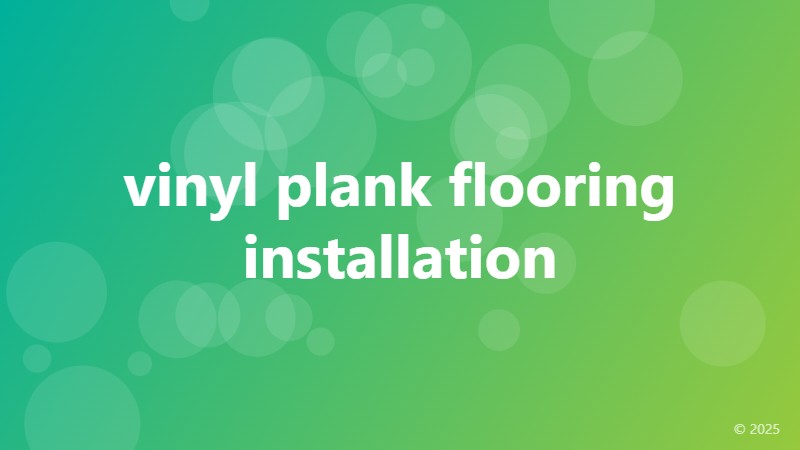vinyl plank flooring installation
 ```html
```html
Understanding Vinyl Plank Flooring Installation: A Comprehensive Guide
Thinking about installing vinyl plank flooring? You've come to the right place. This comprehensive guide will walk you through every step of the vinyl plank flooring installation process, from preparation to finishing touches. Whether you're a DIY enthusiast or hiring a professional, understanding the process ensures a smooth and successful project resulting in a beautiful, durable floor.
Preparing Your Subfloor: The Foundation for Success
A successful vinyl plank flooring installation begins with a properly prepared subfloor. Unevenness, moisture, and debris can all lead to problems down the line, such as buckling, warping, and premature wear. Before you even think about laying down planks, take the time to assess your subfloor. This involves cleaning thoroughly, repairing any cracks or holes, and ensuring it’s level. For significant imperfections, consider using a self-leveling compound to create a perfectly smooth surface. Moisture is a critical concern; use a moisture meter to check for excessive humidity. If the moisture levels are too high, you'll need to address this before proceeding, potentially requiring the use of a moisture barrier.
Choosing the Right Underlayment: Enhancing Comfort and Durability
Underlayment isn't just an optional extra; it's a crucial component of a successful vinyl plank flooring installation. It provides cushioning, sound insulation, and a barrier against moisture. The type of underlayment you choose will depend on factors like the subfloor condition and your personal preferences. Some underlayments are designed specifically for concrete subfloors, while others work better with wood. Consider the thickness – thicker underlayment provides more cushioning but might increase the overall height of the floor.
Acclimating Your Vinyl Planks: Avoiding Future Problems
Before you even open the boxes, allow your vinyl planks to acclimate to the room's temperature and humidity. This is crucial, especially in environments with fluctuating conditions. Leaving the unopened boxes in the room for 24-48 hours allows the planks to adjust to the environment, minimizing the risk of expansion or contraction after installation. This simple step can prevent issues later on.
Installing Your Vinyl Plank Flooring: A Step-by-Step Guide
With the subfloor prepared and the planks acclimated, you're ready for installation. Most vinyl plank flooring utilizes a click-lock system, making DIY installation relatively straightforward. Start in a corner, ensuring the first row is perfectly aligned with the wall. Follow the manufacturer's instructions carefully, as methods can vary slightly between brands. Use a tapping block and pull bar to ensure tight joints and prevent damage to the planks. Remember to leave expansion gaps around the perimeter of the room, allowing for movement. Careful planning and precise cuts are key to achieving a professional-looking finish.
Dealing with Tricky Areas: Cuts and Transitions
Inevitably, you'll encounter tricky areas like doorways, pipes, and uneven walls. Using a sharp utility knife and measuring carefully will ensure clean cuts and a seamless transition. For complex cuts, consider using a jigsaw for greater precision. Transition strips can help seamlessly connect vinyl plank flooring to other flooring types, like carpet or tile. Proper planning and the right tools will make these areas less daunting.
Finishing Touches: Protecting Your Investment
Once the installation is complete, take time to admire your new floor! However, the final step is crucial – cleaning up any debris and protecting your investment. Vacuum or sweep away any excess dust or remnants of the installation process. Use appropriate cleaning solutions as recommended by the manufacturer to maintain the pristine condition of your vinyl plank flooring for years to come.
Hiring a Professional: Weighing the Pros and Cons
While DIY installation is possible, hiring a professional installer offers several advantages, including expertise, speed, and a warranty on their workmanship. If you're unsure about tackling the project yourself or have a particularly complex floor plan, it's worth getting quotes from experienced vinyl flooring installers. Consider the cost vs. your time and skill level when making your decision.
Troubleshooting Common Vinyl Plank Flooring Installation Problems
Even with careful planning, some problems might arise. Buckling could indicate moisture issues, while gaps might signify improper installation. Consult the manufacturer's instructions or seek advice from a flooring professional to address these issues promptly. Early detection and prompt action are key to resolving minor problems before they escalate.
Maintaining Your Vinyl Plank Flooring: Long-Term Care
Proper maintenance will prolong the life of your new vinyl plank flooring. Regular sweeping or vacuuming is essential, along with occasional mopping using a pH-neutral cleaner. Avoid harsh chemicals or abrasive cleaners that could damage the surface. Following these simple steps will help keep your floors looking their best for many years to come.
```